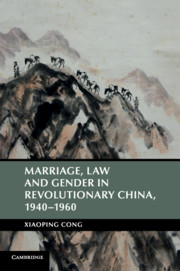Book contents
- Frontmatter
- Dedication
- Contents
- List of figures
- List of maps
- List of tables
- Acknowledgments
- Map
- Introduction
- Part I Locality, marriage practice, and women
- Part II Legal practice and new principle
- Part III Politics and gender in construction
- Epilogue: “Liu Qiao'er,” law, and zizhu : beyond 1960
- Bibliography
- Index
Epilogue: “Liu Qiao'er,” law, and zizhu : beyond 1960
Published online by Cambridge University Press: 05 September 2016
- Frontmatter
- Dedication
- Contents
- List of figures
- List of maps
- List of tables
- Acknowledgments
- Map
- Introduction
- Part I Locality, marriage practice, and women
- Part II Legal practice and new principle
- Part III Politics and gender in construction
- Epilogue: “Liu Qiao'er,” law, and zizhu : beyond 1960
- Bibliography
- Index
Summary
The reform of marriage and family in twentieth-century China was an important project that involved various social forces and a multilayered and multifaceted process. This social movement produced its own images and neologisms that demonstrate the dynamics between imported urban ideas and the adaptive process that evolved in the implementation. In return, these images, symbols, and neologisms reconstructed the state ideology and guided social practice.
The historical trajectory, in which the marriage dispute of Feng v. Zhang was transformed from a local instance to the making of the image of Liu Qiao'er as a national icon, and from a legal case to a cultural symbol, epitomized the changing relationship of Chinese women to family and state in the twentieth century. If Feng Peng'er's action represented women's agency that spontaneously challenged patriarchal domination, as many rural women did before her, the ending of her case can be seen as a turning point in which the revolutionary state worked with women to empower them. By creating the image of Liu Qiao'er, the state set up a political/moral model for women, encouraging them to engage with their agency. In mobilizing women to participate in social reforms, the state reshaped gender relations between the family and state, and the individual and society. Thus the image of Liu Qiao'er symbolizes the revolutionary power that integrated female agents into its agenda for social reform. It was in this process that neologisms such as zi-zhu began to emerge, which crystalized and conceptualized the revolutionary experience in its social practices that also recast the dynamics between the state and family. As the society and the life of the protagonists have moved on, the image of Liu Qiao'er and the neologism, as a part of revolutionary legacy, continued to play their roles even after the 1960s by making new history in contemporary China.
The ongoing story of Liu Qiao'er: Feng Zhiqin, Yuan Jing, and Xin Fengxia
From the 1950s onward, the three women involved in the making of the image of Liu Qiao'er experienced varied paths. In the 1960s Feng Zhiqin continued to enjoy the honor brought by the image of Liu Qiao'er and her dedication to public service; she served as the people's representative and director of the women's association until the beginning of the Cultural Revolution in 1966.
- Type
- Chapter
- Information
- Marriage, Law and Gender in Revolutionary China, 1940–1960 , pp. 272 - 283Publisher: Cambridge University PressPrint publication year: 2016



